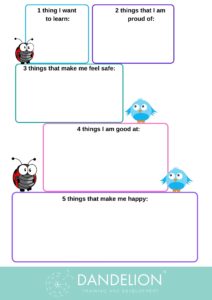Children’s Activity: Self-esteem Chart
Self-esteem
Self-esteem is the value we place on our own worth. It is the opinion we have of ourselves. The way we view our worth in the world. It can be positive or negative, and the level of our self-esteem impacts the way that we see the world and the events that occur in our lives.
What does positive (or high) self-esteem look like?
Positive self-esteem can look like:
- Being able to recognise our strengths
- Being able to recognise our achievements
- Feeling positive about life and the opportunities around us
- Taking chances and opportunities
- Seeking out things that they enjoy
- Caring about appearance / health
- Being honest about self
- Can spend time alone
- Ability to say no
- Being excited about new opportunities
- Talking about their successes
- Realistic expectations
- Bounce back from adversity learning the lessons from it
- Being authentic
- Healthy boundaries
- Take responsibility for actions
What does negative (or low) self-esteem look like?
Negative self-esteem can look like:
- Talking about ourselves negatively
- Criticising ourselves
- Criticising our ability
- Seeing ourselves as less able than friends/family/peers
- Finding it hard to express feelings/thoughts
- Feeling unable to say no
- Feeling unable to rise to challenges
- Feeling incompetent
- Apologising for their existence
- Constantly saying ‘sorry’
- Avoiding things as we believe we will fail
- Overthinking
- Always seeing the worst case scenario
- Hide from others
- Avoiding new or challenging things
- Difficulty to make choices
- Anxiety
- Stress
- Reduced academic performance
- Can lead to – drug and alcohol use
- Can lead to – self-harm
Helping children to recognise their strengths and positive traits is a great first step to supporting them to develop their self-esteem.
Activity to share
So, this week, we are sharing our Self-esteem charts that you can complete with children, to help them recognise their strengths, as well as the areas that they would like to develop. A fun, simple and constructive conversation which places emphasis on our positives.

How to us it:
- Download the activity sheet (HERE)
- Find a quiet space
- Take time to talk through each question
- Praise thoughts, feelings expressed and ideas
- Make a plan to move forward
Further help
For more articles about mental health visit – ARTICLES
To learn more about child and adolescent mental health visit – COURSES
For resources to support child and adolescent mental health visit –RESOURCES
© Dandelion Training and Development – All Rights Reserved

